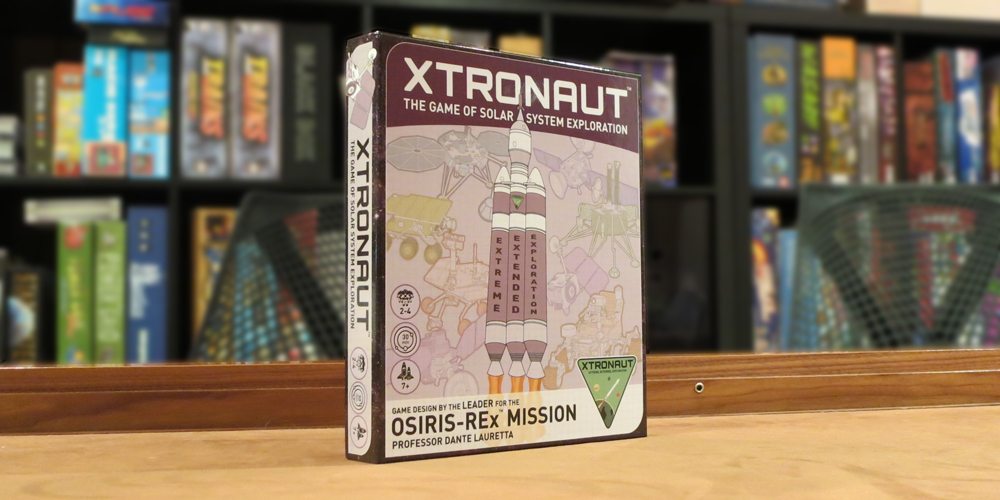
We first alerted you to today’s sponsor, Xtronaut: The Game of Solar System Exploration, when it was being Kickstarted last year. The game was borne from budget cuts to NASA’s OSIRIS-REx mission and Dante Lauretta, the Principal Investigator, got creative by designing a game to try to help the public understand the challenges that projects like OSIRIS-REx face.
The Kickstarter project was a success and Xtronaut is now available to purchase. True to the original mission, the game is a challenge and you’ll face roadblocks to launch along the way, but it’s a straightforward challenge that can be overcome with just a bit of cooperation. The best part is that you’ll likely learn something during play. OSIRIS-REx is scheduled to launch in just a few weeks, so it’s a great time to learn about that mission and space exploration through this game.
What Is It?
Xtronaut: The Game of Solar System Exploration, is a set collection game for 2-4 players, ages 7 and up, which plays in about 30-60 minutes. The game is based on real missions and science. What’s more, players face some of the unfortunate real-world hurdles that scientists do when trying to do their jobs. It’s a game that’s part simulation, part education, and all fun.
The game was designed by the leader of the OSIRIS-REx mission, which is scheduled to launch September 8. The mission is planned to put a spacecraft in close proximity to an asteroid, Bennu, and collect samples from its surface. The craft will then return to Earth so that the samples can be studied to get a better picture of how life originated on Earth. The mission will take seven years to complete. To reiterate, we’re going to visit a friggin’ asteroid to collect samples so we can learn more about life here. How absolutely, unbelievably, and wonderfully amazing is that!!?
While the game was developed using Kickstarter funds, it originated as part of an after-school program at the Boys and Girls Clubs in Tucson. (Dante Lauretta is a Professor at the University of Arizona’s Lunar and Planetary Laboratory.) With the help of Cox Communications, the game and a 15-week STEM science club was implemented in the Boys and Girls Clubs of Metropolitan Phoenix.
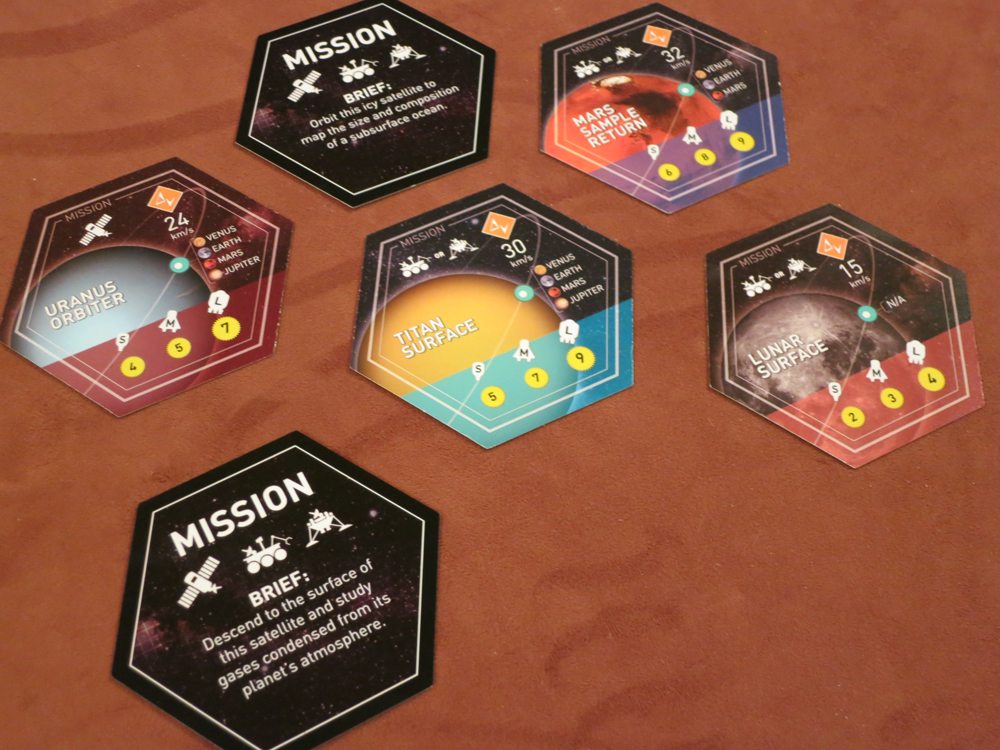
Components
The game comes in a box that’s refreshingly properly sized to its contents; no oversized box here. Inside, you’ll find four jumbo, 11″ x 17″ player boards in tactile-pleasingly thick cardboard. There are 29 Mission Cards, shaped in hexes the size of your palm and printed on heavy stock. Then there are 108 Playing Cards, also printed on thick paper, and a handful of wooden bits for tracking progress and points for each player.
The boards are mostly identical, with the exception of identifying color and each having a different location for launch, where you place your Mission Card. The board is dominated by placeholders for the different element cards you’ll need to launch your mission. Some are mandatory, others are optional, and these are noted on the board. Along the side, there is a track for charting the game’s currency, ∆V, or Delta – V, the change in velocity. At the top, there is a score track. Each mission, you’ll gather data points, more or fewer, depending on the size of your spacecraft and mission. First to ten data points, wins.
Both the Mission Cards and Playing Cards are wonderfully illustrated and have clear, easy-to-understand iconography. Further, the Player Cards are broken into product lines, so players can choose to build a rocket from SpaceX’s Falcon, Space Launch System, or United Launch Alliance’s Atlas or Delta IV lines. The quality of all components is very impressive and its clear no corners were cut in the game’s development.
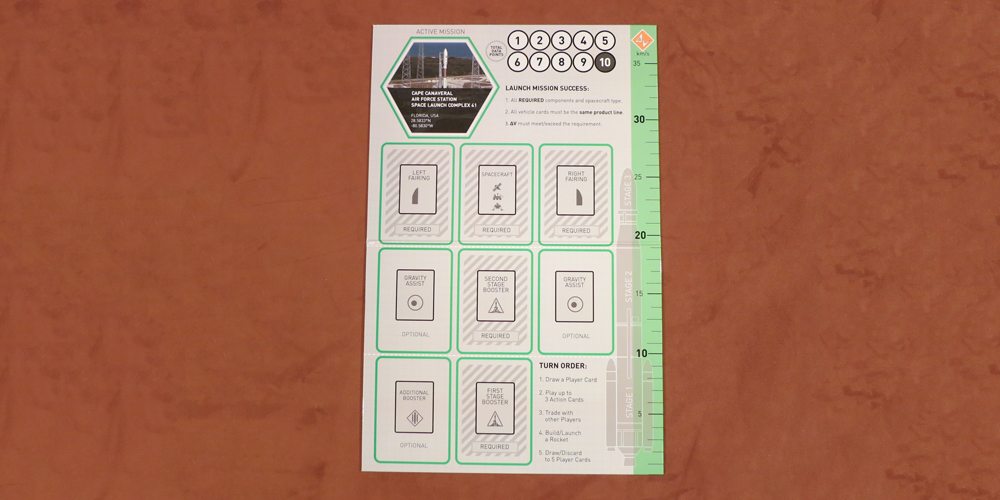
How to Play
The game is a race to be the first to ten data points. This is done by players taking turns executing five phases each, per round. Players each take turns executing these phases, though there is plenty of player interaction when it’s not your turn. Setup for the game is easy. Each player takes a Player Board and its corresponding wooden markers, which are placed off the scoring track and at the low point on the ∆V tracker. Cards are shuffled and everyone receives a random Mission Card and five Player Cards. The player who has most recently looked through a telescope gets to go first.
On a turn, a player first draws an additional Player Card. These cards come from one of three categories. First are the vehicle parts that make up the assembly of the rocket and are one of the main focuses of the game. There are, essentially, six parts: a right and a left fairing, second and first stage boosters, additional boosters, and the spacecraft, itself. Additionally, there are planet cards that can be used as gravity assists, helping with ∆V, should your mission allow them, and Action Cards.
The second phase allows a player to play up to three Action Cards, which either give the player a benefit or throws a little “take that” at the player’s opponents. You might be able to draw four additional cards, steal cards from your neighbor, or set up a government shutdown, which prevents another player from participating in the game in a couple of ways.
Next, a player can trade cards with other players. Any trade must involve the active player, but are fairly unlimited in their scope. Trades can involve cards in hand or on boards. Cards must be traded, rather than given, and these trades may involve the development of alliances against another player, future trades, or boycotts against a player. These future deals aren’t necessarily binding. It can get pretty cutthroat.
As the fourth phase, a player can play as many cards toward their mission rocket as they like. Cards already played can be substituted or removed. If the rocket is complete, it is during this phase that the rocket launches. Finally, the player may discard as many cards as desired before drawing back up to five cards, which is the maximum hand at the end of a turn.
When players are managing their hands and building their rockets, there is a single concern, ∆V or the required change in velocity. Each Mission Card has a required ∆V that a player must achieve, but it’s up to the player to meet or exceed that value by finding the proper Vehicle Cards. Some boosters provide more velocity and what each element is capable of is dependent on the size of spacecraft a player selects for the mission. Small crafts are light and allow booster to generate more velocity, but reward fewer data points at launch. Large crafts suck up a lot of power and velocity, but provide big rewards at launch. Still, with a large craft sitting on your launch pad, you may still find yourself coming up short on delta-v. Fortunately, Gravity Assists may deliver the final few ∆V you need to launch.
There are three conditions that a player has to meet to launch a rocket. First, each of the mandatory elements must be filled on the player’s board (both fairings, spacecraft, and second and first stage boosters). Next, each of those elements has to be from the same product line – no mixing and matching allowed. Finally, the player must double-check to make sure that the ∆V has been met or exceeded. Only then may the rocket launch. Once it does, the player is dealt three new Mission Cards. He reads the back of the card, which has a synopsis, and chooses one. Only then may he look at the opposite side, which has details of the mission.
The second condition, that elements be of the same product line, is the reason why the trade portion of the game is so important. Players must reach friendly relationships with other players, in order to assemble a rocket that is within the game’s specs. Lastly, a player checks to see if she has reached 10 Data Points and a win. If not, play continues!
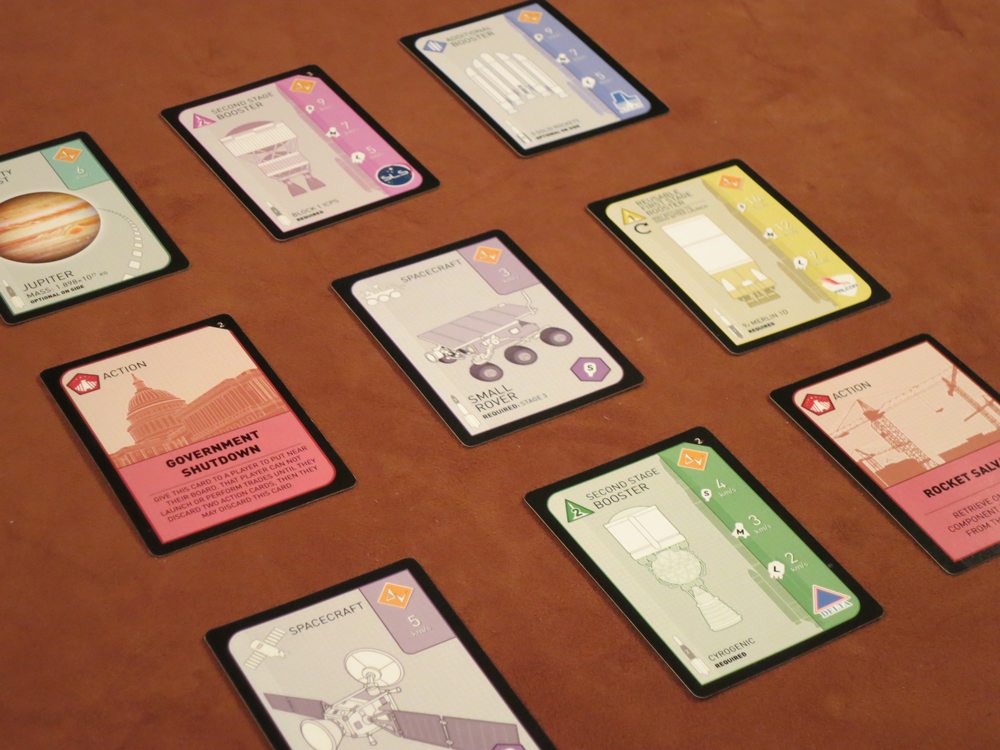
Verdict
There’s a feeling you get, about a couple rounds into your first game of Xtronaut, where you start to get a sense of some of the frustrations that scientists face when having to battle politicians and accountants, rather than just doing science. There are just enough action cards that hint at the roadblocks in the form of audits and government shutdowns to get that sense. Fortunately, they’re offset by budget surplus cards, spare parts, and the willingness of other players to help.
Perhaps it’s just the people I play games with, but playing the game with different groups, players naturally gravitated to building from different product lines and were generous in helping each other find missing vehicle parts (until the end of the game became evident, that is).
What’s more, there’s a bit of education in this game too: in the needs of the Mission Cards, the Player Cards to get there, and the challenges to overcome. But that’s not all. The rulebook is a healthy 20 pages long, but half of it is dedicated to education and outreach for the OSIRIS-REx mission and space exploration, in general. There’s science to learn and activities for kids to complete. It’s a fantastic package.
Reading about the game, we really looked forward to building rockets for missions, sort of the cardboard version of Kerbals Space Program. It was that, but the trade and negotiation aspects of the game are ones that we didn’t fully anticipate, but grew to really appreciate. None of us could build a rocket without help from the others — there aren’t enough elements from a product line that you’ll find them all without the help of trades — so the “take that” cards were discarded early in the game, only to come out late in the game, as a player was drawing close to 10 data points.
Speaking of those data points, they encompassed the single home-brewed rule we’ve made to improve Xtronaut. Rather than move up the score track, from one to ten, we’ve opted for a 10-9-8 countdown on the track. It’s just a little change, but it helps build on the theme and counting down out loud is ever so much fun.
Xtronaut is a very enjoyable game. Building a rocket that meets mission parameters is a challenge that’s not only fun, thanks to the trading and negotiation with other players, but is educational at the same time. It’s definitely worth checking out. Xtronaut: The Game of Solar System Exploration is available at Amazon and Walmart today for just $35.
This post was sponsored by Xtronaut: The Game of Solar System Exploration, but all opinions here are my own.



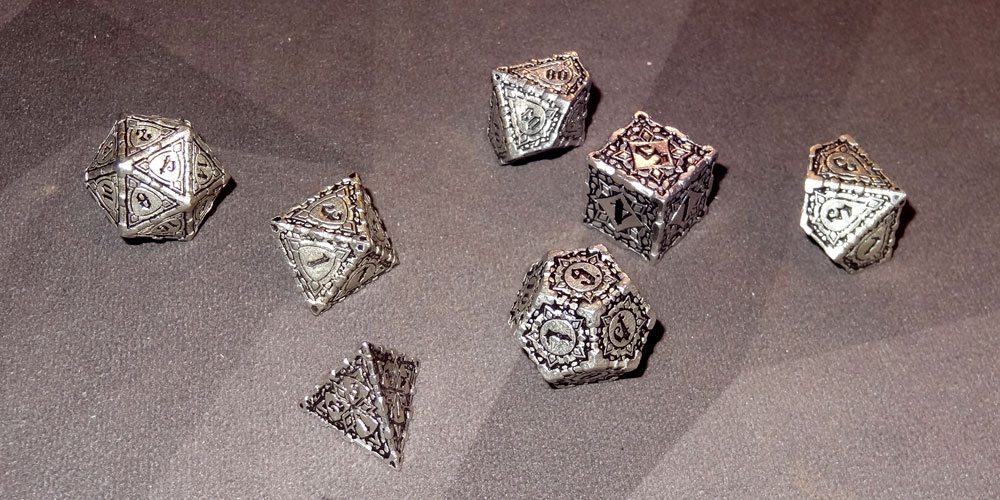
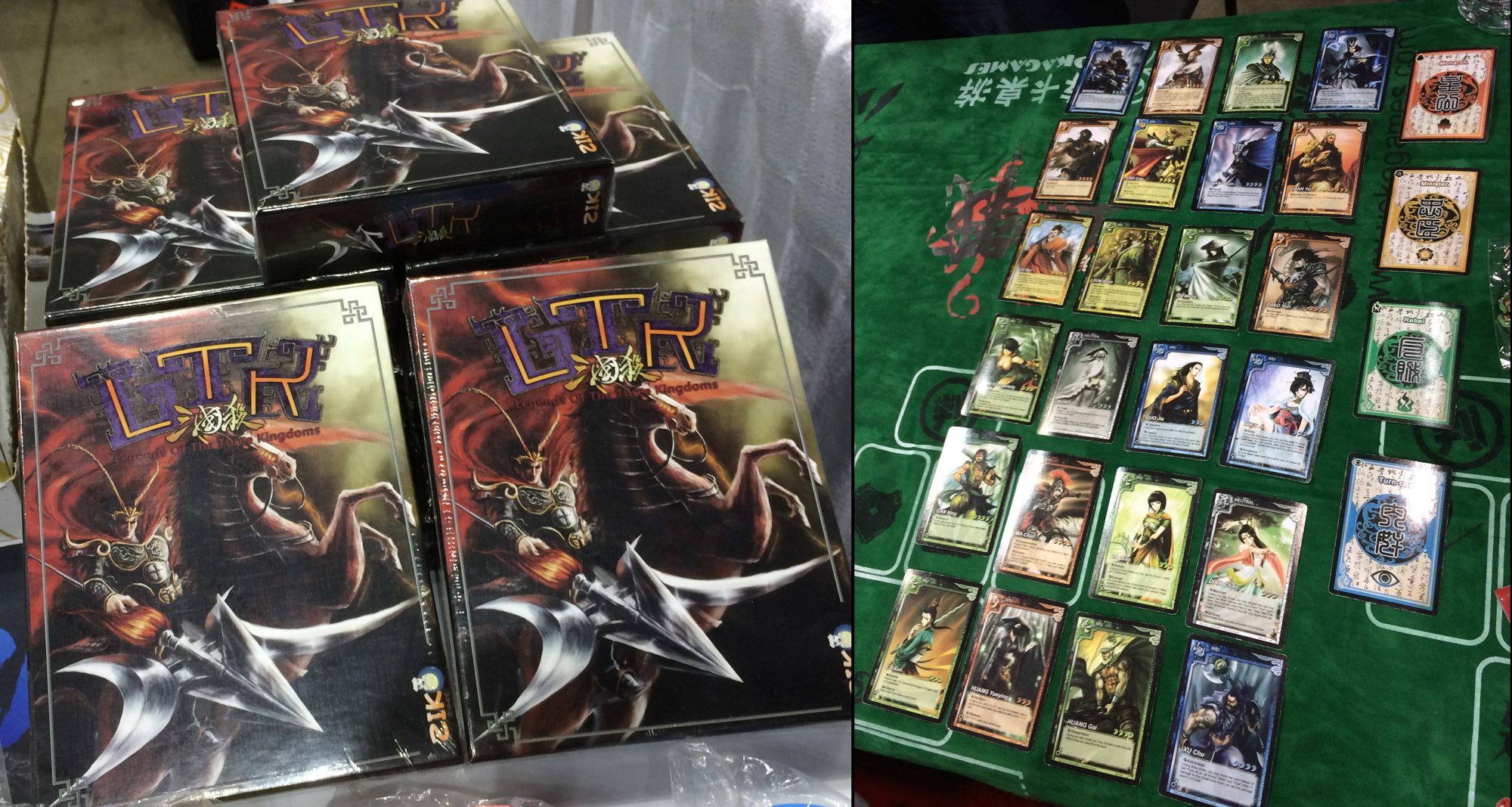
Great books, thank you for the informative post!